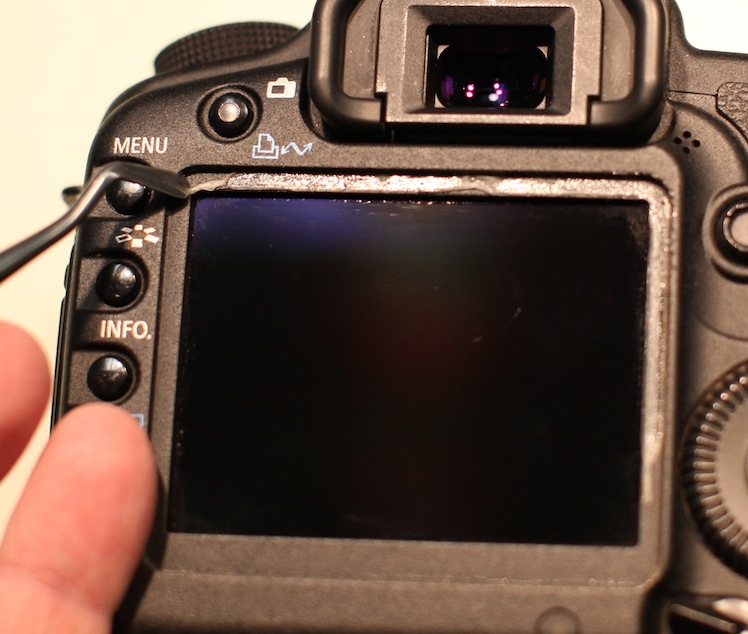How To's
How to Change your Camera’s LCD Cover
Inevitably, over time the plastic LCD cover on the back of your camera gets scratched, scuffed and generally ends up looking older than the camera really is. Most of the time it doesn’t matter much, you can see the images and menus just fine. But given enough scratches light glare may interfere with seeing the LCD. Or you just may hate that your pride and joy doesn’t look great. We certainly do.
Changing that old LCD cover for a new one is easy to do and inexpensive. We’re going to show you how using a 5D Mk II for an example, but changing it out on other cameras is exactly the same (as is changing out smaller secondary LCD covers if your camera has those). For almost all Canon and Nikon cameras you can find factory replacement covers (and tape, make sure it comes with tape) on eBay or from some camera repair shops that resell parts. You can also buy them direct from Canon or Nikon parts at the moment, but Nikon plans to stop selling all parts soon except to authorized repair centers (who won’t resell parts) so Nikon supplies will probably be drying up. You can sometimes find LCD covers for other brands, but they’re more difficult to come by.
Once you have the new cover, changing won’t take more than 15 minutes. And I should note, all we’re doing is changing the cover, we aren’t doing anything to the actual LCD itself. BUT, if you’re clumsy you could scratch the actual LCD while doing this and that will require an expensive repair. So consider yourself warned.
Tools and Parts
First, you need a camera with a nasty LCD cover like this one:

Plus a shiny new replacement LCD cover and the tape needed to apply it (about $20-$35 on eBay depending on the camera)

As for tools all you need is a hair dryer and something flat and thin to pry up the old screen: X-acto knife, very small flat screwdriver, etc.
Taking the old cover off
Use the hairdryer on medium heat to slowly warm up the LCD cover on the camera. You need to get it warm to the touch to soften the adhesive, but you don’t want to cook the camera’s electronics. How warm? Well, like I said warm (not hot) to the touch. I’m not OCD enough to take the temperature of the screen, but it usually takes 2-3 minutes on medium heat.

Once it is warm, find the corner of the LCD cover that seems to have the most room to insert a small knife, screwdriver, etc. Personally, I use a lens cloth under the tools to protect the camera’s finish and find that two pry tools work better than one. The cover is only a mm or so thick and you DON’t want to let the tool move over the LCD screen if it slips. Notice in the picture that both tools are aimed away from the LCD.

Different people recommend different ways to do this. One of the more common is to go ahead and break the cover which makes it easier to pull up. I haven’t been able to summon up the guts to try this method, so I stick with prying up. It may take a couple of times reheating and reprying but once a corner starts to come loose, the screen will pull up very easily.
Finally, you’ll need to clean up. There will almost always be some old tape left that you can gently scrape off with a screwdriver blade or similar tool. I do  not recommend using an adhesive remover – you don’t want any gunk getting on the LCD. As for the LCD screen itself, simply blowing it off with a rocket blower should be all you need to do. But if necessary we’ve found using a Lenspen or soft brush causes no problems.
not recommend using an adhesive remover – you don’t want any gunk getting on the LCD. As for the LCD screen itself, simply blowing it off with a rocket blower should be all you need to do. But if necessary we’ve found using a Lenspen or soft brush causes no problems.

Applying the New Screen
For most cameras, the replacement tape comes on an LCD size pad with a center protective area – the double-sided strip of tape is only around the edges. Simply remove the paper over the tape

and apply it to the LCD area.

Smooth it down firmly and then remove the paper backing, leaving only the tape behind. It always amazes me how easily this works.

Make one last check to see if any dust has settled on the LCD, then place the new cover on top of the tape, press down on the edges firmly, and you’re all done. Nice, shiny clean new LCD cover!!!

Strictly for your benefit, my readers, I have demonstrated what happens if you don’t check the underside of the new LCD cover for dust before you apply it. If you notice it (like I did) before you’ve pressed the edges down tightly you can probably pry a corner up and blow it out. If not, well, go back to step 1.
Roger Cicala
Lensrenals.com
February, 2012
Author: Roger Cicala
I’m Roger and I am the founder of Lensrentals.com. Hailed as one of the optic nerds here, I enjoy shooting collimated light through 30X microscope objectives in my spare time. When I do take real pictures I like using something different: a Medium format, or Pentax K1, or a Sony RX1R.
-
Zoltan
-
Jared M
-
Samuel Hurtado
-
Danny W
-
Carl
-
Peter Leong
-
David
-
Mandeno Moments
